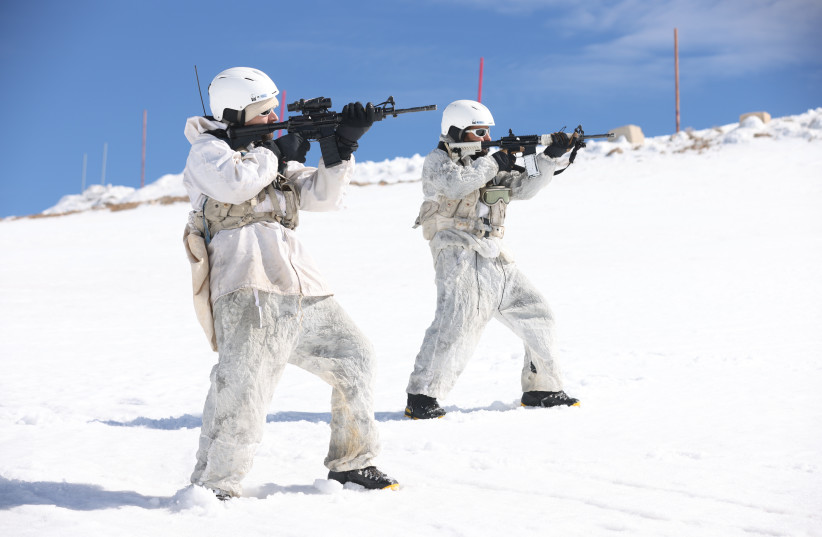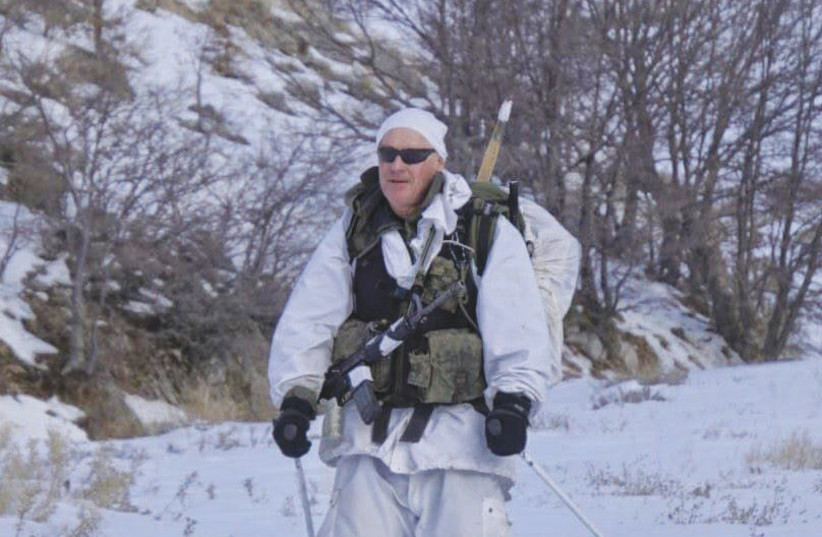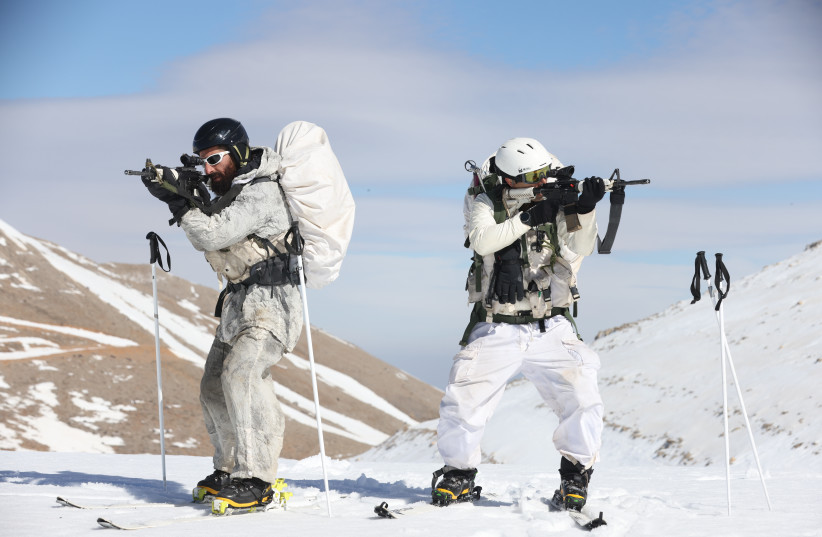On a warm, sunny day, hundreds of Israelis flocked to Mount Hermon. It was so packed that a checkpoint outside the northern Druze city of Majdal Shams was turning people away.
Snow was already melting at the bottom of the mountain, where visitors who had booked tickets gathered. But we were heading up, above the clouds and past the peak where the tourists began to ski down the slope.
The 20-minute ride in the back of an IDF BV (Bandvagn 206) armored all-terrain vehicle was bumpy as we packed in with the troops from the Alpinist Unit along with their skis and other gear.
The military’s alpine unit consists of reserve soldiers who served in elite infantry units during their active duty. In the winter, they patrol Mount Hermon, which straddles the Lebanon and Syrian borders, wearing all white – from their sunglasses down to their skies.
Despite the bumps and the feeling of being on a roller coaster, the unit’s fighters joked about the coronavirus and warned us that it would be much colder at the peak than it had been at the bottom.

The Israeli-controlled side of the mountain reaches a height of 2,225 meters. On a clear day, Syria’s capital – only 40 km. away – can be seen, about as far away as Kiryat Shmona, and half the distance to Tiberias.
Mount Hermon has always been a strategic asset, and while it has been referred to as “the eyes of the country,” with its advanced listening and other technology, it is now referred to as “the eyes and ears of the country.”
Maj. (res.) Stephan Kogeus has been serving in the IDF’s Alpinist Unit since 1982, after he immigrated from Sweden.
Kogeus, who also served in the Swedish military’s alpine unit before moving to Israel, recounted that when he arrived, troops were not even using skis to patrol the hill.
“I was shocked,” he said, describing what he saw when he first got to the unit. “The unit was established after the Yom Kippur War, but they wore snow sandals and it was difficult for them to navigate and fight in the snow. Their equipment was just not suitable. I brought my skis from Sweden and started walking next to them while they were still wearing their snow sandals, it was awful.”
Kogeus, who is the oldest member of the unit at 67, has been skiing since he was a young child. After more than 30 years in the unit, he remains a fighter in the unit and acts as a consultant to younger team members to impart his decades of experience and knowledge of the hill.
It is because of him that the fighters of the Alpinist Unit have all of their current equipment and skills.
“Over the years the unit has improved,” he said, but, “it was not easy to teach them at the beginning. I had to be very diplomatic because some of the fighters in the unit thought they knew everything.”
He explained that toward the end of the 1980s, a commander from the Golani Brigade arrived and agreed to listen to him about the skis and winter equipment.
“For example, the topic of being able to walk and navigate with skis in the snow, and how to sleep and stay outdoors in winter conditions... at first, the fighters preferred to sleep in tents but sometimes it’s better to sleep in snow caves. I brought this from my experience in Sweden,” Kogeus explained. “We were then able to improve everything and turned the unit into an elite force.”

Capt. (res.) Amir Chukrun has been in the unit for almost 17 years, being recruited after serving in the elite Sayeret Golani during his mandatory service. He serves as the commander of the unit’s training and told the Magazine that reservists face challenging conditions that regular reservists do not experience on a day-to-day basis.
“They come from Sayeret Golani and Egoz but [to serve on] the Hermon needs a lot of experience, be it to be able to fight in conditions such as extreme winds,” he said, adding that the “mountain demands us to be modest and to have experience.”
While the members of the unit sometimes change, “we try as best as we can to keep our people,” Chukrun said, explaining that by staying in the unit, the reservists are able to build up their expertise of the mountain and the threats facing it.

According to Kogeus, the longer fighters have been with the unit, the better.
“It’s good to have older fighters, they are gold. They know the terrain and the different extreme weather conditions. You know the whole spectrum of the weather, navigation, self-confidence, which are very important. To understand a hill and snow, that comes only with years of experience,” he said. “Those who have been there for years, you can trust them because they know the hill like the back of their hand.”
There are no women serving in the unit, which is made up of reservists who in their mandatory service served in units like the Egoz commando brigade or Golani, and range between 30 to 67 years old.
As the oldest member of the team, Kogeus has no plans to stop serving. “It’s not hard for me. Sometimes it’s actually harder for the younger guys, who work harder, whereas, for me, everything about the snow comes naturally.”
Most do not know how to ski when they come to the unit and learn everything from scratch before they undergo specialized training at the IDF’s special military alpine school on the Hermon during the winter where they learn how to dress, patrol on the snow in extreme cold weather conditions and more.
“These are techniques that take time,” Kogeus explained. “It’s not like skiing for fun. You are walking long distances with your weapons, heavy gear, helmet and navigating – 95% of the time off-piste and sometimes climbing.”
But once they master the art of winter warfare, along with their special equipment and tools to navigate in the winter terrain, these fighters provide protection from attacks by terrorists from Syria or Lebanon.
Israel seized most of the strategically located Golan Heights from Syria in the 1967 Six Day War. Jerusalem later annexed the territory in a move never recognized by the international community.
While the borders near the Hermon have been relatively quiet, several anti-aircraft missiles were fired toward Israel’s only ski resort in recent years from Syria, where Hezbollah – described by senior military officers as the strongest army in the Middle East after the IDF – continues to have a large presence.
Israeli officials have repeatedly voiced concerns over Iran’s presence in Syria and the smuggling of sophisticated weapons to Hezbollah from Tehran to Lebanon via Syria, stressing that both are redlines for the Jewish state.
Israel and Hezbollah fought a 33-day war in 2006, coming to an end under UN Security Council Resolution 1701, which called for the disarmament of Hezbollah, withdrawal of the Israeli army from Lebanon, the deployment of the Lebanese army and an enlarged UN force in southern Lebanon.
Though the defense establishment does not see a war breaking out with Iran or its proxies, such as Hezbollah in Syria, Israel’s military has increased the amount of training for troops and reserve forces like the Alpinist Unit.
THE THREATS facing the troops who serve on the Hermon “are a mix of the winter and the enemy who is in Lebanon and Syria,” Chukrun said.
“We understand that the enemy can use the weather to its advantage but we are keeping ahead of them by doing a lot of missions, many of them secret, in order to keep the quiet and the security of this mountain.”
The IDF has been training on the Golan Heights for another war with the terror group, which over the years since the Second Lebanon War has morphed into a more mobile army with more advanced weaponry, able to draft large amounts of fighters and deploy them quickly into enemy territory.

A week before the Magazine joined the unit, Hezbollah released a video showing the group’s elite ski unit taking to the slopes in southern Lebanon preparing to fight against Israel. In a video shared on Twitter, at least eight Hezbollah terrorists were seen firing assault rifles and handguns toward Israeli targets while on skis and snowmobiles.
The video, which was accompanied by dramatic music, also showed the operatives doing hand-to-hand combat in the snow and warning Israel that “Hezbollah has a characteristic – that fear marches in front of it.”
Like IDF troops in the military’s reserve Alpinist Unit, the terrorists in the video were wearing white uniforms to camouflage with the snow in southern Lebanon.
But, Kogeus stressed, Israel’s unit is not a real alpine unit like those in Europe or in North America. “It’s more of a mountain unit,” he said, adding that Hezbollah’s ski unit is also not a real alpine unit.
“They have the capabilities to go up against us, but how many of them really know how to ski? What we see in the video are 10 people who are on snowmobiles and shooting. It’s not very exciting. It probably took them a whole day to film a video that lasts one and a half minutes,” he said.
“We don’t need to be afraid, but we have to be ready. Snowmobiles are a tool and they can get here really quickly, and if there are those who want to attack us in bad weather, they can do damage. But how many of them really know how to deal with the snow, how to navigate and survive in winter conditions?”
According to Chukrun, an attack on the Hermon would not be part of a larger operation but a more specific terror attack carried out by Hezbollah.
“A Hezbollah ambush would happen in fog or bad weather when there is low visibility. I am sure that Hezbollah knows our capabilities and won’t attack us, but we are preparing for the day that they do,” he said. “We are always watching them, including the video that they just put out. I’m saying this modestly, but if they do decide to come and attack, we will win.”
Hezbollah’s alpine unit is similar to its elite Radwan Unit, which is expected to be at the forefront of any Hezbollah attack against Israel, infiltrating into Israeli communities along the border to kill as many civilians and troops as possible, accompanied by a massive barrage of rockets, mortars and anti-tank missiles.
Chukrun told the Magazine that in addition to years of battlefield experience and regular drills, they also have a good amount of winter capabilities and tools.
“We aren’t worse than them, but I’m saying this modestly and giving them the respect they deserve because they gathered a lot of battlefield experience in Syria, including in the winter, and we understand that,” Chukrun said.
But Israel’s “Alpinistim” “have a lot of new capabilities and tools including Ski-Doos [snowmobiles],” he said, adding that they also know how to use the snow to their advantage and build snow caves where they can remain for an extended period of time.

“We have some of the best fighters in the army,” he said as we spoke in one of the caves dug into the side of the mountain as the unit’s fighters were resting down below after a patrol along a windy edge of the mountain.
One of the fighters was Maj. (res.) Oren Sela, who was recruited to the unit 15 years ago after he served in Sayeret Golani and Sayeret Matkal (General Staff Reconnaissance Unit) during his mandatory service.
Sela, the weapons officer of the unit, told the Magazine that the unit is the only one in the IDF with skis and other winter equipment because of the extreme weather that they have to deal with. While their weaponry is the same as other military units, due to the terrain, snipers in the unit use rifles with the longest range in the army, able to hit targets over a kilometer away.
According to Sela, while the unit has in the past gone to Germany and Switzerland for training and other joint drills, it hasn’t happened for several years due in part to political and bureaucratic reasons.
And while North America has great mountain ranges for training, “we haven’t done anything with the US and Canada because the Hermon is so different from the mountains in Alaska or the Rockies. Being so close to the sea, it is a micro-climate of its own. Come in the morning and the ice is like cement and then in the afternoon, it’s like slush. Our needs are so different than in North America.”
According to Kogeus, the unit has trained in Switzerland on navigation and dealing with avalanches, but the exercises did not have the troops drill on winter combat with their weapons. And not training with militaries with more experience and knowledge of winter warfare is a major loss for the IDF.
“I tried a few years ago to start a joint cooperation with the 10th Mountain Division in the US, which has a lot of experience and we could have learned a lot from them, but for some reason, it didn’t happen,” he said. “I know and understand that if we had trained with militaries in the world we could have dealt better and given our unit the push to learn how to really fight in the snow.”
Kogeus said that he would be glad to have the 10th Mountain Division, which has seen deployments to Afghanistan and Iraq, come and train in Israel.
“It can be very, very important for us to learn from them, and we aren’t doing that at the moment. You have to find the right person to get this to happen.”
WHILE THE threat level “constantly” goes up and down, “there are patrols every day and we check every morning that there are no signs of infiltrations,” he said.
And infiltrations don’t only mean individuals crossing into Israel. Last February, an Israeli woman crossed into Syria from Majdal Shams next to the Hermon. She was arrested by Syrian authorities and interrogated as a possible spy after she reached the village of Hadar. She was later returned to Israel after a deal was reached via Russian mediators.
Following the incident, the unit went to several dead areas of the mountain to check where reconnaissance and military observers were blind, in order to find solutions and make sure that such an incident wouldn’t occur again.
Two and a half weeks before we observed the unit, Hezbollah patrolled along the entire border, and “afterward we patrolled to see exactly where they went and where they spent more time. One of our missions is to make them see us and think twice about what they are doing.”
According to Kogeus, it is unlikely that Hezbollah would attack in the winter but rather in the summer when the conditions are more favorable.
“It’s not easy for the enemy to get to us in the winter. They aren’t stupid, they can fire missiles in the winter. But to fight against us in the winter, Hezbollah would have to be suicidal.”
As the unit’s fighters finished their patrol, finding no signs of a Hezbollah infiltration, we climbed back in the BV to head down the mountain. We watched as tourists skied or snowboarded down the hill, oblivious to the armed soldiers on skis protecting them from threats just across the border. ■
